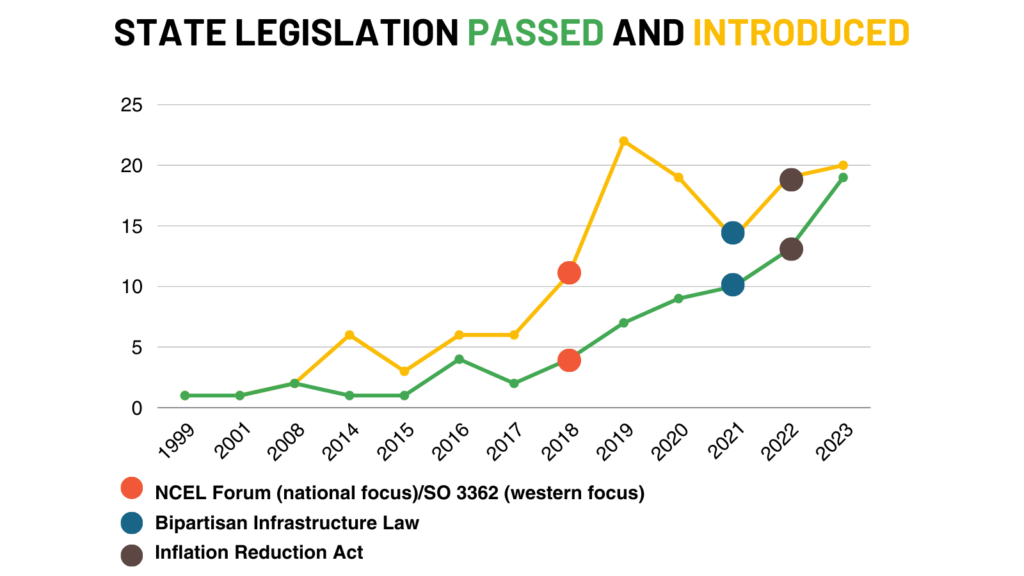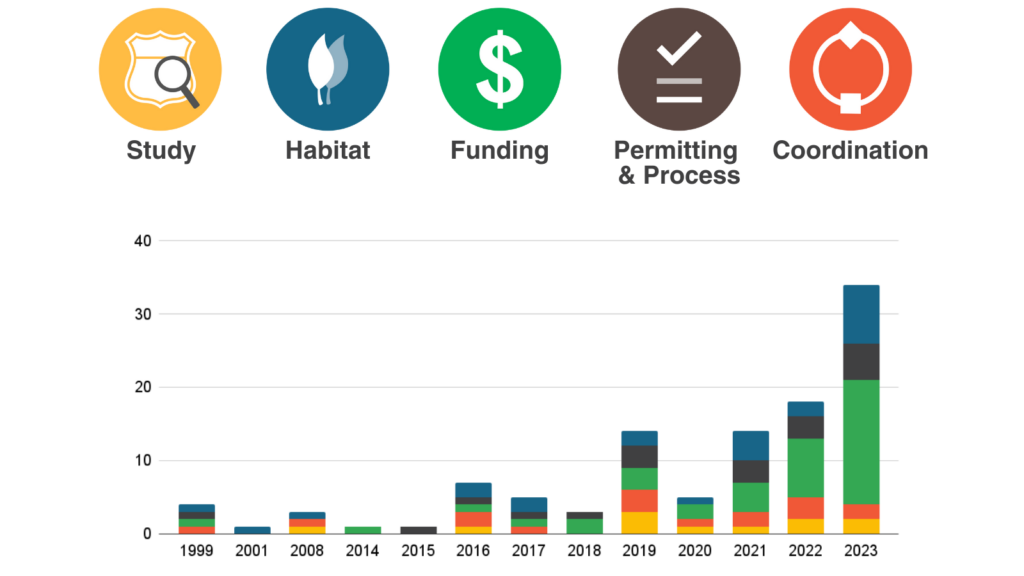
Press Release
New Report: State of the States: A Look at How Far U.S. State Habitat Connectivity Legislation Has Advanced and What is Working
May 14, 2024
80% of Habitat Connectivity Legislation has Passed within the Last Five Years
Since 2019, 66 habitat connectivity bills have successfully connected vast landscapes and improved roadway safety for both humans and wildlife.
Washington, DC – Today NCEL and Wildlands Network released a new report detailing how far U.S. state habitat connectivity legislation has rapidly advanced and what is working.
Biodiversity loss stands as one of the most pressing environmental challenges globally, primarily driven by habitat fragmentation and destruction. Such fragmentation can lead to a reduction in biodiversity by up to 75%, emphasizing the critical importance of habitat connectivity, conservation, and restoration in addressing the biodiversity crisis.
States have led this effort for years, but their actions alone aren’t enough. Wildlife doesn’t recognize state borders. Support from all levels of government, Tribal engagement and assistance, and local and private landowner buy-in and participation are needed.
How to Use This Report
This new report analyzes legislation from the past 25 years to identify the key trends and drivers in legislation. It is designed for policymakers in states with and without connectivity legislation. For states lacking such legislation, this report provides models and examples of what other states have done. Meanwhile, for those with existing legislation, this document analyzes existing laws and implementation and can be used to identify gaps.
At A Glance: Top Insights and Takeaways
- Support from Multiple Levels of Government: Looking at the introduction versus passage of bills shows the importance of the Wildlife Crossings Pilot Program through the Bipartisan Infrastructure Law. Many bills were introduced before this program following NCEL’s National Forum in 2018. However, success rates dramatically increased after this program highlighting the need for support from multiple levels of government.
- Need for Dedicated Funding: Significant funding supported some of the most successful state crossing and corridor policies. Examples of this include Florida’s appropriation of $850 million to protect critical linkages within the Florida Wildlife Corridor and Utah’s appropriation of $20 million to leverage federal funding for wildlife crossings. This highlights the need for permanent funding solutions to support conservation and infrastructure year after year. Utah was one of the first states to enact permanent funding for crossings by allocating $1 million per year in non-lapsing funds. Wyoming has tapped an existing permanent trust fund to annually support habitat connectivity projects.
- Bipartisan Support: Wildlife crossings provide a clear co-benefit as they simultaneously increase public safety on our roads and protect wildlife. As a result, this win-win conservation tool has attracted bi-partisan support.
Digging Deeper: What is Driving Habitat Connectivity Legislation?
Since 1999, 83 pieces of habitat connectivity legislation have been passed in the United States, with 80% passing since 2019. Drivers of this increasing success include Wildlands Network’s presentation at NCEL’s National Forum, continued support from numerous other conservation organizations including NCEL and Wildlands Network, the Bipartisan Infrastructure Law, and the Inflation Reduction Act.

“NCEL has been assisting state legislators on habitat connectivity policy for nearly a decade with support from Wildlands Network,” said Logan Christian, NCEL’s Wildlife and Habitat Coordinator. “This report highlights the power of educational events and our Wildlife Corridors and Crossings Working Group, which allows legislators to learn from other states and replicate proven approaches, combined with federal funding.”
Looking at Legislative Trends to See What’s Working
In addition to highlighting the drivers of habitat connectivity legislation, the report analyzes states that have passed legislation and what is working. Of the passed legislation, five categories have emerged over the years – studies and plans, coordination, funding, permitting and process, and habitat. The report highlights specific state successes for each of these categories and demonstrates opportunities for further advancement.

“Crossing legislation is crucial, but we urge interested communities to not forget about the broader significance of wildlife corridors”, said Erin Sito, U.S. Policy Director at Wildlands Network. “We have to think beyond roads – we have to think about the large landscapes that we’re trying to connect with these wildlife crossings because for wildlife to thrive, conservation has to happen on both sides of the road.”
The report also includes a full glossary of enacted legislation labeled with these five categories and sorted by state. This glossary provides state legislators and other interested parties with a resource that can help them understand whether their state has already passed legislation, what other states have done, and whether there are opportunities for improvement within their own states through additional legislation.
Learn more and view the full report State of the States: A Look at How Far U.S. State Habitat Connectivity Legislation Has Advanced and What is Working
This report and educational tool were made possible through the generous support of the Doris Duke Foundation. Wildlands Network and the National Caucus of Environmental Legislators are incredibly grateful to the Doris Duke Foundation for its generous support.
For more information, please contact:
Taylor Anderson, National Caucus of Environmental Legislators, taylor@ncelenviro.org
Erin Sito, Wildlands Network, e.sito@wildlandsnetwork.org
###
Created by and for state legislators, the National Caucus of Environmental Legislators is a 501(c)(3) nonprofit that organizes over 1,300 environmentally-committed state legislators from all 50 states and both parties. NCEL provides venues and opportunities for lawmakers to share ideas and collaborate on environmental issues.
ncelenviro.org | @ncelenviro
Wildlands Network is a conservation organization dedicated to reconnecting, restoring, and rewilding North America. Over thirty years ago, Wildlands Network’s founding scientists were among some of the first in the nation to develop a connected landscape vision to combat habitat loss and fragmentation. Today, the organization’s state-level efforts have resulted in 21 pieces of state legislation passed and over $58 million in dedicated state funding to support wildlife crossing infrastructure and habitat connectivity conservation projects.
wildlandsnetwork.org | @wildlandsnetwrk